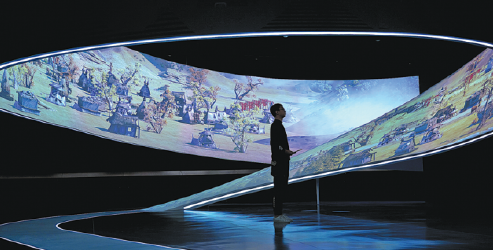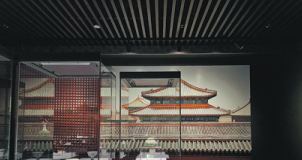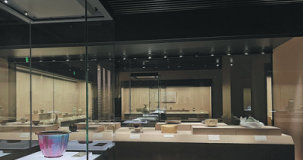A special gallery for visitors allows them to interact with the digital version of the renowned Ming Dynasty (1368-1644) painting Silk Road Landscape.
An exhibition of ceramics from the imperial kiln in Jingdezhen during the Ming Dynasty (1368-1644).
An exhibition of ceramics from the imperial kiln in Jingdezhen during the Ming Dynasty (1368-1644).
The Shimao art collection exhibition hall.
It has just opened but its traditional design is already a landmark. The complex of buildings, located in Shishi, a county-level city in Fujian province's Quanzhou, features red walls, raised platforms, roof ridges curling up like swallowtails and stone archway replete with exquisite carvings.
The private museum has as its theme the history of the ancient Maritime Silk Road of which Quanzhou was a hub. The Shimao Martime Silk Road Museum of Fujian was established by property developer Shimao Group with active support from the Palace Museum.
The museum, combining the elegance of the traditional redbrick architecture in Minnan, or southern Fujian province and the magnificence of the palace cluster at the Palace Museum, aims to provide a model for the possible collaboration between State-owned museums and the non-State-owned ones.
Covering an area of around 11,500 square meters, the museum consists of five main buildings within which there are exhibition halls to display cultural treasures from the Palace Museum, the collections of the Shimao group and these cultural relics related to the evolvement of the Maritime Silk Road. A special gallery for visitors allows them to interact with the digital version of the renowned Ming Dynasty (1368-1644) painting Silk Road Landscape.
Besides a storehouse of cultural relics and a museum-themed restaurant, stores selling cultural and creative products and other facilities are also set in place.
The ongoing exhibitions in the museum include one recreating wedding scenes during the Qing Dynasty (1644-1911) and an exhibition of ceramics from the imperial kiln in Jingdezhen during the Ming Dynasty (1368-1644).
Cai Mengya, Party secretary of Shishi, says that the launch of the museum represents a milestone in the history of the city's cultural sector. The city will carry out a series of package tours, featuring visits to the museum, the ancient village of Huashan lined with Minnan-style buildings and other historical sites in and around the city.
Xu Rongmao, chairman of Shimao Group, was born in Shishi city in 1950. He says that he wants to contribute to the cultural richness of his hometown by locating the museum in the city. Meanwhile, he hopes that fellow citizens could enjoy their heritage as those living in Beijing, Shanghai and other metropolises.
He believes that the museum will get people closer to the historical stories of how dwellers in coastal areas of Fujian province maintained trade contacts or conducted cultural exchanges with countries alongside the ancient Maritime Silk Road, which would help to nourish amity among people from relevant countries.
"I hope more young people would come to look around the museum," says Xu, adding that an annual activity that invites 2,000 or so Hong Kong students to visit the museum will be organized in the following years.
Shimao group also plans to set up more museums, galleries, the cultural resources or tourism towns in cities that boast ample cultural resources.
"By tapping the potential of a city's cultural resources to fuel its cultural development, we can also undertake the layout and expand the bases of Shimao Group's cultural industry," says Xu.
In recent year, Xu has been highlighting the importance of forging innovative collaboration between State-owned and private museums.
He suggests that the two sides could cooperate in designing cultural and creative products and co-hold educational activities or tourism events. Training sessions could be run by State-owned museums to improve the professionalism of the private museums' staff in protecting,
displaying and managing collections as well as carrying out scientific research on cultural relics.
State-owned museums can cooperate with private museums and galleries to curate influential, high-quality exhibitions to promote private brands. In the meantime, the mixture of collections from the latter will fill up the blanks in the themes of State-owned museums' exhibits, Xu adds.
In this sense, the founding of Shimao Maritime Silk Road Museum of Fujian, supported by the Palace Museum, is, in some way, exploring a collaborative model that benefits the two sides and increases the efficiency of resource allocation.
The Shimao Group, led by the billionaire Xu, has maintained a good relationship with the Palace Museum. In 2016, it donated 80 million yuan ($12.4 million) to the Palace Museum for the renovation of the Hall of Mental Cultivation, or Yangixin Dian. In the next year, Xu purchased Silk Road Landscape, the Ming Dynasty scroll painted with special blue and green mineral colors which had been kept in a private Japanese museum for more than seven decades, and then donated it to the Palace Museum.
"These efforts have created mutual trust between us," says Wang Xudong, director of the Palace Museum. "We'd like to spare no effort to support the construction of the Maritime-Silk-Road-themed museum."
The Palace Museum has collected more than 20,000 pieces of cultural relics related to the Maritime Silk Road, according to Wang.
As a State-owned museum, the Palace Museum should instruct the private museum to develop in a sustainable way via passing on our lessons in the preservation of cultural relics, museum management and other aspects, says Wang.
Li Zhongmo, curator of the private museum, says that they must guarantee, a hundred percent, the safety of these precious collections of the Palace Museum when shipping them from Beijing to Shishi.
He also points out that the daily operation, the control of the humidity and temperature in the buildings and the protection of cultural relics should all be considered after the museum's opening.
We aim to develop it into an excellent public cultural service platform that has international influences and an attraction that helps to boost the tourism in Fujian province, he says.





